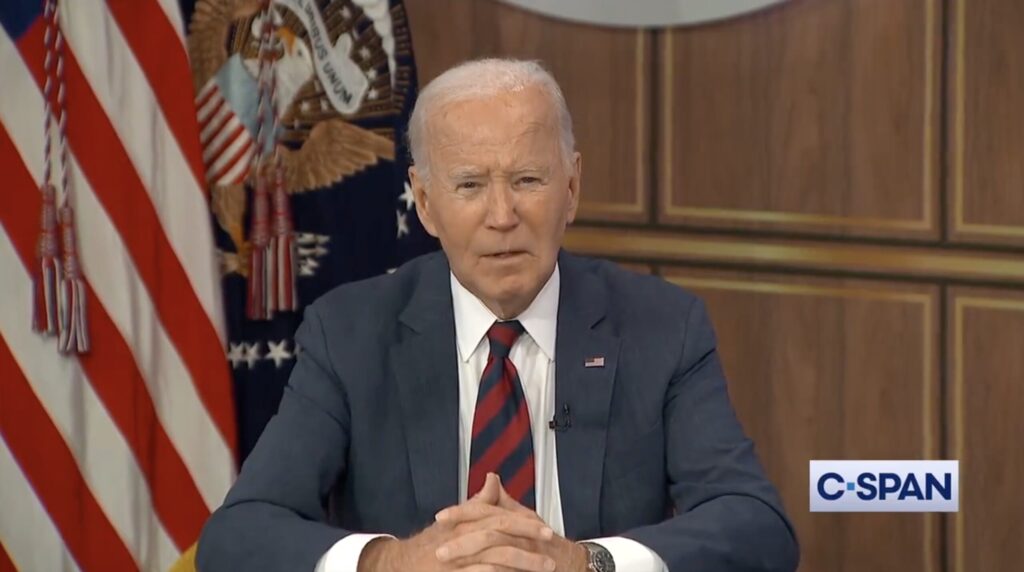In a recent virtual briefing concerning Hurricane Milton, President Joe Biden dismissed allegations made by Representative Marjorie Taylor Greene regarding potential government interference in weather patterns, branding her claims as “beyond ridiculous.” During this briefing, Biden condemned Greene’s remarks, accusing her of promoting misinformation that not only puts lives at risk but also erodes public trust in federal disaster response initiatives. This exchange highlights a deeper discussion surrounding the controversial topic of weather manipulation, which, while not mainstream, has historical precedent. Greene’s assertions have not only drawn ire from Biden but have also ignited a conversation regarding the need for government transparency related to weather modification activities, particularly focusing on the lesser-known Weather Modification Act of 1972 and federal records related to weather modification projects.
In her initial post to her 1.2 million X (formerly Twitter) followers, Greene stated that the government can control weather, insisting it is “ridiculous” for anyone to claim otherwise. However, a community note appended to her tweet clarified that while small-scale weather manipulation techniques like cloud seeding exist, broader weather patterns are natural phenomena that cannot be fully controlled. Interestingly, this clarification suggests some legitimacy to Greene’s argument as it acknowledges that weather manipulation is indeed possible, albeit on a limited scale. Greene’s commentary point towards a rising concern that climate change is being likened to a widespread pandemic, urging citizens to inquire about governmental roles in weather manipulation, questioning whether individuals consented to such interference and if they bear the financial burden for it.
Greene’s claims included references to National Oceanic and Atmospheric Administration (NOAA) documents that reportedly list over 1,000 instances of weather modifications, which she claims only scratch the surface of governmental activities related to weather manipulation. She criticized the perceived lack of transparency regarding these activities, calling into question the government’s accountability when natural disasters linked to weather modifications result in property damage or loss of life. In her tweets, Greene asked if people had given permission for the government to modify the weather that could challenge citizens’ rights and government accountability, advocating for compensation for any damages caused.
The Weather Modification Act of 1972 requires companies involved in weather modification to report certain activities to the NOAA at least 10 days prior to execution. The Act outlines specific activities that qualify as weather modifications—ranging from cloud seeding to releasing substances into the atmosphere to influence weather characteristics. This regulatory framework indicates that while there is oversight for such activities, it raises broader questions regarding the implications of weather control technologies for societal safety and individual rights. Greene pointed out that under this Act, the NOAA contains a database of recorded weather modification activities, suggesting that such government actions warrant public scrutiny.
Historically, the government’s involvement in weather manipulation can be traced back to the Vietnam War, during which the U.S. reportedly used cloud seeding as part of covert operations to create harsh weather conditions intended to disrupt enemy movements. Although the government renounced this practice for hostile uses in 1972, it reflected a complicated relationship between environmental manipulation and military strategy. Additionally, international discussions in the 1970s aimed at banning environmental modifications as weapons suggest the magnitude and seriousness with which this issue has been treated historically. The juxtaposition of past experiences with present claims creates a complex narrative that intertwines scientific capabilities with ethical considerations and public safety.
As global climatic conditions continue to shift, instances of extreme weather events have brought renewed attention to the capabilities of modern technology to affect weather patterns. For example, extreme rainfall in the United Arab Emirates recently led some to conclude that cloud seeding practices were responsible, illustrating contemporary realities that evoke both concern and interest in weather modification techniques. Reportedly, such practices have gained increased technological sophistication, raising debates on their legitimacy and safety. Reports from notable media outlets have recognized these advancements, sometimes describing them as governments exerting significant control over natural weather processes amid the urgency of climate-related challenges.
In summary, the discourse surrounding Rep. Greene’s claims about government weather manipulation highlights significant issues around government transparency and accountability. While prominent figures, such as President Biden, reject her assertions, the underlying conversations about the implications of weather modification technologies continue to evolve. The ramifications of government activities under laws like the Weather Modification Act of 1972, combined with historical precedents, suggest a nuanced framework that advocates for a more informed public dialogue regarding weather manipulation—one that incorporates scientific discoveries and ethical dilemmas presented by shifting climatic patterns. Ultimately, this conversation will require careful navigation between skepticism, scientific advancement, and the pursuit of public safety in the face of increasingly unpredictable weather phenomena.

